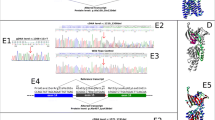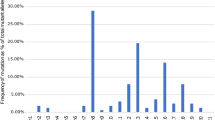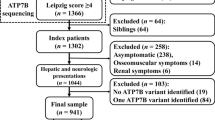Abstract
The gene ATP2C1 is identified as the defective gene in Hailey–Hailey disease (HHD). The nonsense and missense are two common types of mutations and have ,respectively, been detected in many HHD patients. The aims of our study were to identify the pathogenic ATP2C1 abnormality in Chinese HHD patients, and to compare nonsense and missense mutations in vivo to provide further understanding of the molecular and the physiological basis of HHD. The nucleotide sequencing of the ATP2C1 gene was performed in HHD patients, unaffected family members and 100 unrelated individuals. Meanwhile, we detected and analyzed the clinical manifestations, the expression of ATP2C1 mRNA and hSPCA1 protein in the two types of mutations. Three heterozygous mutations were identified, including a previously reported nonsense mutation (R799X), two novel missense mutations (D644G) and (R417K). The results of comparisons between two types of mutations showed that the common clinical features, the similarly low-level expressions of ATP2C1 mRNA and hSPCA1 protein, but the ATP2C1 mRNA expression of nonsense mutation was lower than missense mutation and even less than half the level of normal people. Our findings expand the known spectrum of ATP2C1 mutations in HHD. We supported the haploinsufficiency theory as prevalent mechanism in both types of mutations, and believed that the differences of ATP2C1 mRNA expressions in peripheral blood may relate with the type of mutation and reflect the state of illness of patients.



Similar content being viewed by others
References
Burge SM (1992) Hailey–Hailey disease: the clinical features response to treatment and prognosis. Br J Dermatol 126:275–282
Chao SC, Tsai YM, Yang MH (2002) Mutation analysis of ATP2C1 gene in Taiwanese patients with Hailey–Hailey disease. Br J Dermatol 146:595–600
Cheng Y, Cheng YM, Zhao G et al (2011) A novel missense mutation of the ATP2C1 gene in a Chinese patient with Hailey–Hailey disease. Biochem Biophys Res Commun 406:420–422
Daiho T, Yamasaki K, Suzuki H et al (1999) Deletions or specific substitutions of a few residues in the NH2-terminal region of sarcoplasmic reticulum Ca2+-ATPase cause inactivation and rapid degradation of the enzyme expressed in COS-1 cells. J Biol Chem 274:23910–23915
Fairclough RJ, Dode L, Vanoevelen J et al (2003) Effect of Hailey–Hailey disease mutations on the function of a new variant of human secretory pathway Ca2+/Mn2+—ATPase (hSPCA1). J Biol Chem 278:24721–24730
Fairclough RJ, Lonie L, van Baelen K et al (2004) Hailey–Hailey disease: identification of novel mutations in ATP2C1 and effect of missense mutation A528P on protein expression levels. J Invest Dermatol 123:67–71
Hu Z, Bonifas JM, Beech J et al (2000) Mutations in ATP2C1, encoding a calcium pump, cause Hailey–Hailey disease. Nat Genet 24:61–65
Kitajima Y (2002) Mechanisms of desmosome assembly and disassembly. Clin Exp Dermatol 27:684–690
Korner J, Rietschel M, Nothen MM et al (1993) Familial cosegregation of affective disorder and Hailey–Hailey disease. Br J Psychiatry 163:109–110
Li XL, Xiao SX, Peng ZH et al (2007) Two novel mutations of the ATP2C1 gene in Chinese patients with Hailey–Hailey disease. Arch Dermatol Research 299:209–211
Majore S, Biolcati G, Barboni L et al (2005) ATP2C1 gene mutation analysis in Italian patients with Hailey–Hailey disease. J Invest Dermatol 125:933–935
Martin J, Behne, Chia-Ling Tu, Ida Aronchik et al (2003) Human keratinocyte ATP2C1 localizes to the golgi and controls golgi Ca2+ Stores. J Invest Dermatol 121:688–694
Nemoto-Hasebe Ikue, Akiyama Masashi, Osawa Rinko et al (2008) Diagnosis of Hailey–Hailey disease facilitated by DNA testing: a novel mutation in ATP2C1. Acta Derm Venereol 88:399–400
Szigeti Re’ka, Kellermayer Richard (2006) Autosomal-dominant calcium ATPase disorders. J Invest Dermatol 126:2370–2376
Sudbrak R, Brown J, Dobson-Stone C et al (2000) Hailey–Hailey disease is caused by mutations in ATP2C1 encoding a novel Ca2+ pump. Hum Molec Genet 9(7):1131–1140
Yan XX, Tian HQ, Yu YX et al (2010) Mutation analysis of ATP2C1 gene in patients with Hailey–Hailey disease. Chin J Dermatol 43(6):393–395
Zhang F, Yan X, Jiang D et al (2007) Eight novel mutations of ATP2C1 identified in 17 Chinese families with Hailey–Hailey disease. Dermatology 215(4):277–283
Zhu YG, Yang S, Gao M et al (2006) Two novel mutations of the ATP2C1 gene in Chinese families with Hailey–Hailey disease. J Dermatol Sci 42:125–127
Acknowledgments
We would like to thank the patients for participating in the study. This work was supported by grant from National Natural Science Foundation of China (No. 30901297), the Doctoral Fund of Youth Scholars of Ministry of Education of China (No. 20090201120074) and the Fundamental Research Funds for the Central University (2009).
Author information
Authors and Affiliations
Corresponding authors
Rights and permissions
About this article
Cite this article
Zhang, D., Li, X., Xiao, S. et al. Detection and comparison of two types of ATP2C1 gene mutations in Chinese patients with Hailey–Hailey disease. Arch Dermatol Res 304, 163–170 (2012). https://doi.org/10.1007/s00403-011-1185-1
Received:
Revised:
Accepted:
Published:
Issue Date:
DOI: https://doi.org/10.1007/s00403-011-1185-1




